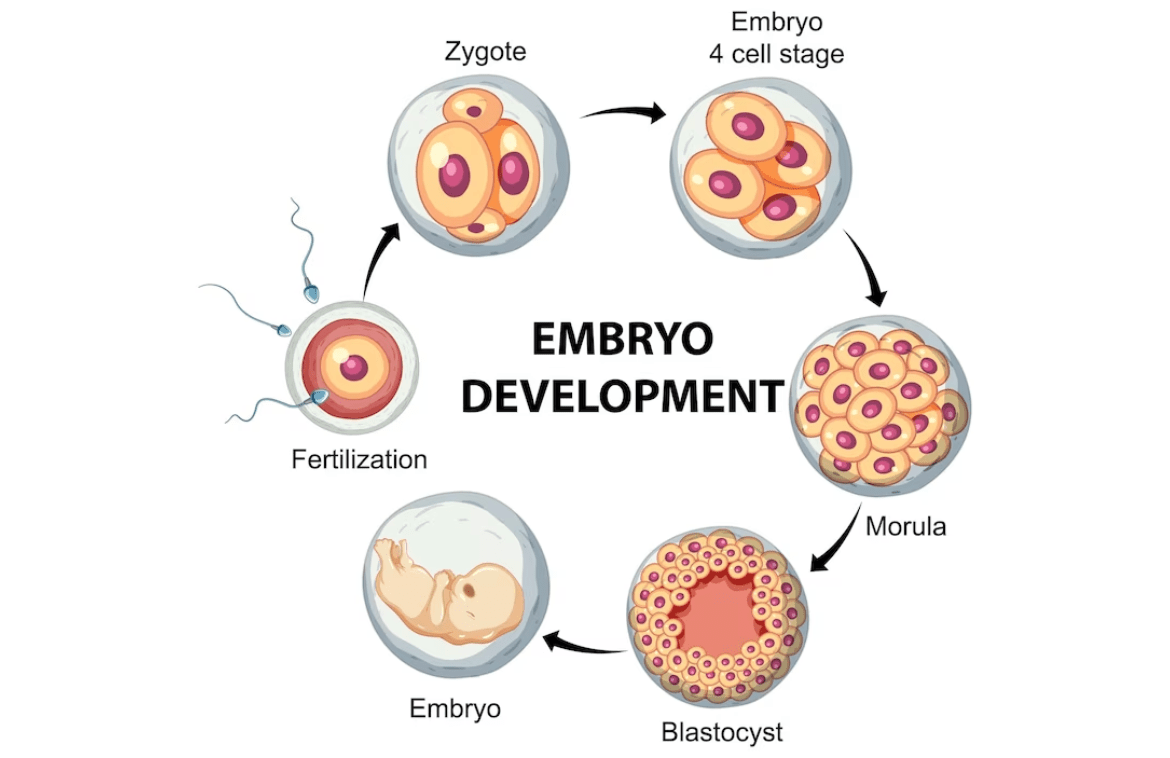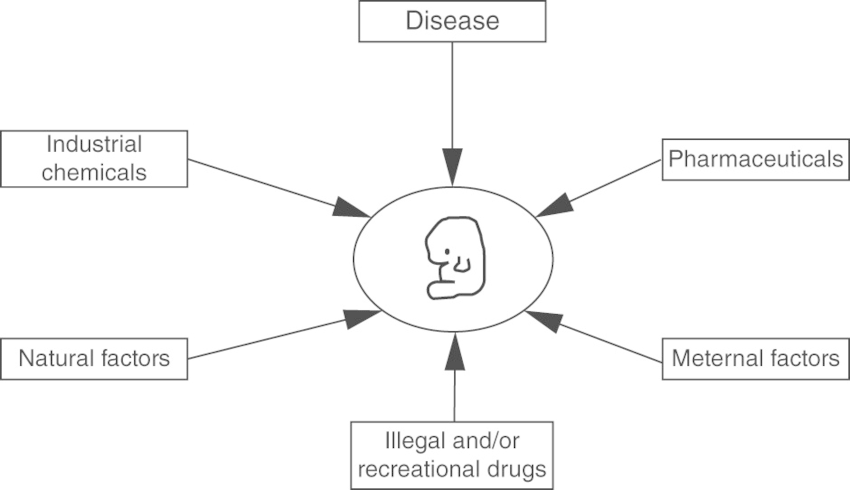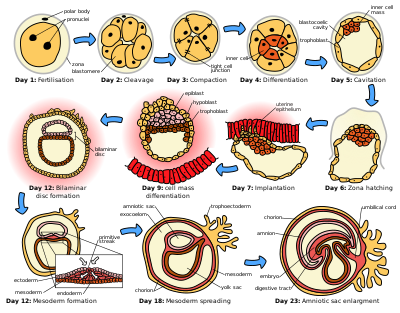Today our topic of discussion is ” Introduction to Embryonic Development “. Embryonic development is a complex, fascinating process that is crucial to the creation of new life. This intricate sequence of events begins with fertilization and continues through the formation of tissues and organs until the eventual birth of a fully developed organism. This article will delve into the various stages of embryonic development, the factors that influence it, and the inheritance patterns that can affect an organism’s development and health.
Introduction to Embryonic Development : Development and Inheritance
Embryonic development, also known as embryogenesis, is the process by which a fertilized egg grows into a fully formed embryo. This stage of development is critical because it lays down the basic body plan of the organism and begins to establish the foundation upon which all subsequent growth and differentiation will build.
Stages of Embryonic Development
Embryogenesis can be divided into several stages, starting from the single-cell stage (zygote) and extending to the fully formed embryo ready for birth or hatching. Here is a detailed look at these stages:
1. Fertilization
Fertilization is the fusion of the sperm and egg cells, resulting in a zygote. This event triggers a series of metabolic changes in the egg that prevent further sperm entry, ensuring that only one sperm fertilizes the egg. The zygote’s genetic material, a combination of DNA from both parents, will guide the entire development process.
2. Cleavage
Following fertilization, the zygote undergoes rapid cell divisions without growth in a process known as cleavage. These divisions result in an increase in cell number but not size, producing a cluster of cells known as a blastula.
3. Gastrulation
Gastrulation is a crucial step in which the blastula reorganizes into a three-layered structure known as the gastrula. These three germ layers – the ectoderm, mesoderm, and endoderm – will eventually give rise to all the tissues and organs of the organism.
4. Organogenesis
During organogenesis, the germ layers differentiate into the various organs and tissues. The ectoderm forms the nervous system and skin, the mesoderm gives rise to muscles, bones, and the circulatory system, and the endoderm develops into the digestive tract and lungs.
5. Morphogenesis
Morphogenesis involves the shaping of the embryo and the development of its external features. It includes the processes of cell migration, differentiation, and growth that contribute to the physical form of the developing embryo.
6. Growth and Maturation
This final stage of embryonic development involves the growth and maturation of the embryo’s structures, preparing it for birth or hatching. This stage is characterized by a dramatic increase in size and the refinement of organ systems.

Factors Influencing Embryonic Development
Embryonic development is influenced by various factors that ensure the proper unfolding of developmental processes:
Genetic Factors
The genetic material inherited from both parents provides the instructions for the development of the embryo. Genetic mutations or variations can result in developmental abnormalities or confer certain traits.
Environmental Factors
Environmental factors such as nutrition, temperature, oxygen levels, and exposure to toxins can significantly affect embryonic development. For instance, certain substances, known as teratogens, can cause congenital defects if the embryo is exposed to them during critical periods of development.
Hormonal Factors
Hormones play a vital role in regulating the growth and differentiation of tissues during embryogenesis. For example, maternal hormones can influence the development of the embryo, especially in species with internal fertilization and gestation.

Development and Inheritance
Inheritance is the process by which genetic information is passed from parents to offspring. The combination of genes inherited from both parents contributes to the unique traits of the individual and can also influence the development of the embryo.
Genetic Inheritance
Genes are inherited in a predictable pattern, according to the laws of Mendelian genetics. These laws explain how dominant and recessive traits are passed on and express themselves in the offspring.
Chromosomal Inheritance
Abnormalities in chromosome number or structure, such as trisomies or deletions, can lead to developmental disorders. For example, Down syndrome is caused by the inheritance of an extra copy of chromosome 21.
Epigenetic Inheritance
Epigenetic changes refer to modifications in gene expression that do not involve alterations in the DNA sequence. These changes can be influenced by environmental factors and, in some cases, can be passed on to the next generation, affecting embryonic development and health.

Disorders of Embryonic Development
There are many potential disorders of embryonic development, often resulting from genetic abnormalities, environmental exposures, or a combination of both. These can range from minor anomalies to major malformations or even embryonic lethality.
Congenital Malformations
These are structural or functional anomalies that occur during intrauterine life and can be identified before birth, at birth, or later in life. Examples include cleft lip and palate, heart defects, and neural tube defects.
Genetic Disorders
These are diseases caused by abnormalities in genes or chromosomes. They can be inherited or result from mutations that occur during embryonic development. Examples include cystic fibrosis and sickle cell anemia.
Teratogenic Effects
Exposure to certain drugs, chemicals, or infectious agents during pregnancy can disrupt embryonic development and cause teratogenic effects. Examples include fetal alcohol syndrome and the effects of thalidomide exposure.

Conclusion
Embryonic development is a remarkable process that encompasses the transformation of a single-celled zygote into a complex, multicellular organism. It involves tightly regulated stages of development, each of which builds upon the previous one to shape the future individual. Understanding the intricacies of embryogenesis is essential for advancing reproductive health, managing congenital disorders, and unraveling the mysteries of life itself.
The factors that influence embryonic development are numerous and diverse, ranging from genetic to environmental. The field of developmental biology continues to explore these influences, seeking to understand how they interact and the mechanisms by which they operate.
Inheritance plays a significant role in shaping the course of embryonic development. It determines not only the genetic makeup of the offspring but also can influence the susceptibility to developmental disorders and the response to environmental factors.
Disorders of embryonic development highlight the delicate balance required for normal development and the profound impact that disturbances in this balance can have on the health and viability of the offspring.
Through continued research and technological advances, our understanding of embryonic development will deepen, enabling better management of developmental disorders and improving the outcomes for affected individuals. Embryonic development is a window into the very foundations of life, reflecting the complex interplay between our genetic inheritance and the environment in which we develop.
Read more:
